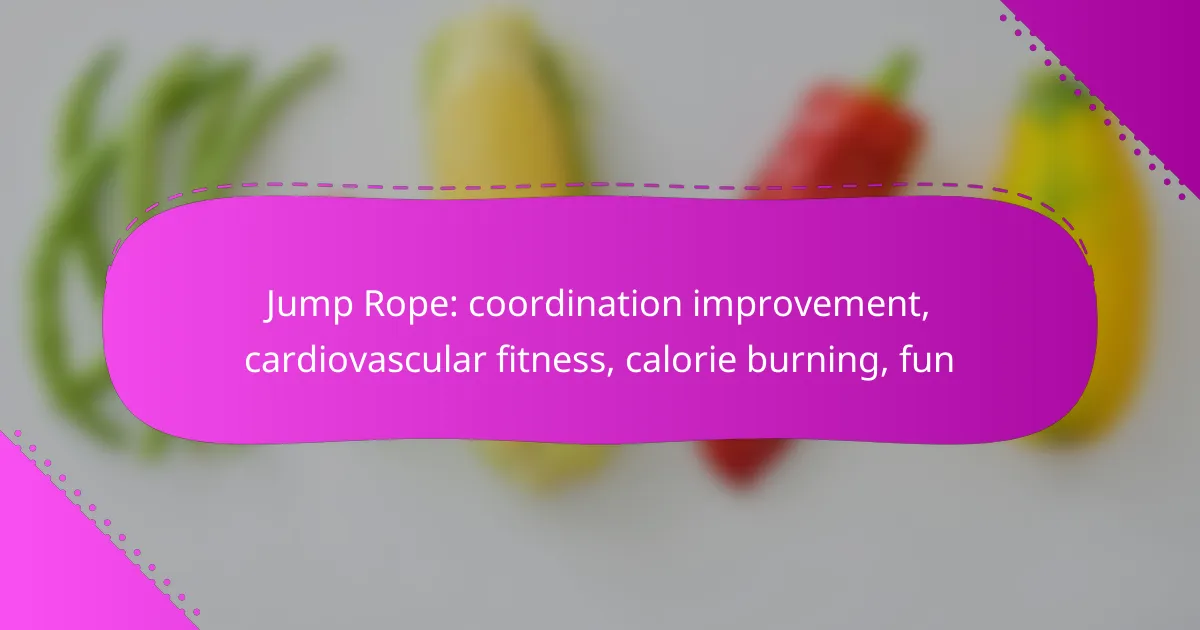Jump rope is a dynamic exercise that not only improves coordination through the simultaneous movement of hands and feet but also enhances cardiovascular fitness. This engaging activity is accessible to all age groups, making it a fun way to boost heart health and endurance while effectively burning calories. With the potential to burn 10 to 16 calories per minute, jumping rope offers a rewarding workout experience that combines fitness with enjoyment.

How does jump rope improve coordination in Australia?
Jump rope significantly enhances coordination by requiring simultaneous movements of the hands and feet, promoting better timing and rhythm. In Australia, this activity is popular among various age groups, making it an accessible way to develop essential coordination skills.
Enhances timing and rhythm
Jump rope exercises demand precise timing to synchronize jumps with the rope’s rotation. Practicing regularly helps individuals develop a sense of rhythm, which is crucial for various sports and physical activities. For optimal results, aim for short sessions of 5-10 minutes, gradually increasing duration as timing improves.
Develops footwork agility
Jumping rope requires quick foot movements, enhancing agility and speed. This agility translates well into other sports, such as basketball or soccer, where quick directional changes are essential. Incorporating different jump styles, like single-leg or double unders, can further challenge and improve footwork agility.
Increases body awareness
Jump rope promotes a heightened sense of body awareness by engaging multiple muscle groups and requiring coordination between them. As individuals become more attuned to their movements, they can better control their body positioning and balance. Practicing in front of a mirror can help enhance this awareness by allowing for immediate feedback on form and technique.
Promotes bilateral coordination
Jumping rope encourages the use of both sides of the body, fostering bilateral coordination. This skill is vital for overall athletic performance and daily activities. To enhance bilateral coordination, try alternating between different foot patterns or incorporating arm movements that cross the midline of the body while jumping.

What are the cardiovascular benefits of jump rope?
Jump rope is an excellent cardiovascular exercise that significantly boosts heart health, improves lung capacity, and enhances overall endurance. Engaging in this activity regularly can lead to better circulation and increased stamina, making it a fun and effective workout choice.
Boosts heart rate effectively
Jumping rope elevates your heart rate quickly, making it a highly efficient cardiovascular workout. Within minutes, you can reach a target heart rate zone, which is essential for improving cardiovascular fitness. Aim for a heart rate that is 70-85% of your maximum during your sessions for optimal benefits.
To maximize heart rate elevation, incorporate interval training by alternating between high-intensity jumps and short rest periods. This method not only keeps your heart rate up but also enhances calorie burning during and after your workout.
Improves lung capacity
Jump rope enhances lung capacity by promoting deeper and more efficient breathing patterns. As your heart rate increases, your body requires more oxygen, which encourages your lungs to work harder. Over time, this can lead to improved respiratory function and endurance.
To further develop lung capacity, focus on rhythmic breathing while jumping. Inhale through your nose and exhale through your mouth, coordinating your breath with your jumps to optimize oxygen intake.
Enhances overall endurance
Regularly jumping rope builds muscular and cardiovascular endurance, allowing you to perform physical activities for longer periods without fatigue. This improvement can translate to better performance in other sports and daily activities.
To enhance endurance, gradually increase your jump rope sessions from short bursts of 5-10 minutes to longer durations of 20-30 minutes. Incorporate variations like double unders or crossovers to challenge your body and keep workouts engaging.

How many calories can you burn jumping rope?
Jumping rope can burn around 10 to 16 calories per minute, making it an effective cardiovascular workout. The exact number of calories burned depends on various factors, including your weight, intensity, and duration of the session.
Burns approximately 10-16 calories per minute
The calorie burn from jumping rope is significant, with most individuals burning approximately 10 to 16 calories for every minute spent jumping. This range can vary based on personal factors like weight and fitness level. For example, a person weighing around 155 pounds might burn closer to 12 calories per minute, while someone heavier could reach the higher end of the range.
To maximize calorie burn, consider incorporating different jumping techniques, such as double unders or alternating foot jumps, which can increase intensity and elevate heart rate.
Varies by intensity and duration
The number of calories burned while jumping rope varies greatly depending on the intensity of the workout and how long you maintain that intensity. High-intensity sessions can lead to greater calorie expenditure, while lower-intensity sessions may burn fewer calories but can still be beneficial for endurance and coordination.
A typical workout might last anywhere from 5 to 30 minutes. For effective calorie burning, aim for at least 15 minutes of continuous jumping at a moderate to high intensity. Remember to listen to your body and adjust the duration and intensity as needed to avoid fatigue or injury.

What makes jump rope a fun workout option?
Jump rope is a fun workout option because it combines physical activity with playful movement, making it enjoyable and engaging. The rhythmic nature and versatility of jump rope routines keep workouts fresh and exciting, appealing to a wide range of fitness enthusiasts.
Variety of styles and techniques
Jump rope offers a plethora of styles and techniques, from basic jumps to advanced tricks like double unders and crisscrosses. This variety allows individuals to customize their workouts based on skill level and personal preferences, keeping the experience dynamic. Incorporating different techniques can also target various muscle groups and improve overall coordination.
For example, beginners might start with basic bounce jumps, while more experienced jumpers can experiment with speed jumps or freestyle routines. This adaptability makes it easy to progress and maintain interest over time.
Can be done solo or in groups
Jump rope can be enjoyed alone or as part of a group, making it a versatile workout option for different social settings. Solo jumpers can focus on personal goals and pace, while group sessions can foster motivation and camaraderie. Both settings provide opportunities for friendly competition and shared learning.
Joining a jump rope class or community can enhance the experience, as participants can exchange tips, learn new techniques, and enjoy the social aspect of working out together. Whether in a park, gym, or at home, the flexibility of jump rope allows for varied workout environments.
Accessible for all fitness levels
Jump rope is accessible for all fitness levels, making it an inclusive workout choice. Beginners can start with short intervals and gradually increase duration and intensity, while advanced jumpers can challenge themselves with complex routines. This scalability ensures that everyone can participate and benefit from the workout.
To get started, all you need is a jump rope and a small space. It’s advisable to wear supportive footwear and choose a flat surface to prevent injuries. Setting realistic goals, such as jumping for a few minutes daily, can help build confidence and endurance over time.

What equipment is needed for jump rope workouts?
To get started with jump rope workouts, you primarily need a jump rope that suits your fitness level and goals. Additional equipment like athletic shoes and a flat surface can enhance your experience and safety.
Choosing the right jump rope type
Selecting the right type of jump rope is crucial for maximizing your workout. There are various types, including speed ropes for fast-paced routines, weighted ropes for strength training, and beaded ropes for beginners who need visual feedback on their rhythm.
Consider your fitness goals when choosing a rope. For cardiovascular fitness, a lightweight speed rope is ideal, while a weighted rope can help with muscle building and endurance.
Importance of proper sizing
Proper sizing of your jump rope ensures comfort and efficiency during workouts. A rope that is too long or too short can hinder your performance and increase the risk of injury.
To find the right size, stand on the middle of the rope and pull the handles up towards your armpits. If the handles reach your armpits, the rope is the correct length. Adjust as necessary by cutting or replacing the rope.
Recommended brands for quality ropes
Investing in a quality jump rope can significantly enhance your workout experience. Some reputable brands include Rogue Fitness, Buddy Lee Jump Ropes, and WOD Nation, known for their durability and performance.
When choosing a brand, look for reviews and feedback from other users. Quality ropes often come with warranties, which can be a good indicator of their reliability and longevity.

What are the prerequisites for effective jump rope training?
Effective jump rope training requires basic coordination, a suitable jump rope, and a safe training environment. Beginners should focus on mastering basic techniques before progressing to more advanced moves.
Coordination Improvement
Jump rope training significantly enhances coordination by requiring the synchronization of hand and foot movements. As you practice, your body learns to time jumps with the rope’s rotation, which can translate to improved agility in other physical activities.
To maximize coordination benefits, start with simple jumps and gradually incorporate variations like double unders or crisscrosses. Consistent practice, even for short sessions, can lead to noticeable improvements in coordination over time.
Cardiovascular Fitness
Jumping rope is an excellent cardiovascular workout that elevates your heart rate, promoting heart health and endurance. Engaging in jump rope sessions can improve your aerobic capacity, making daily activities easier and enhancing overall fitness levels.
For optimal cardiovascular benefits, aim for at least 150 minutes of moderate-intensity jump rope training each week. This can be broken down into shorter sessions, making it easy to fit into a busy schedule.
Calorie Burning
Jump rope training is an effective way to burn calories, with estimates suggesting that you can burn several hundred calories in just 30 minutes, depending on your weight and intensity level. This makes it a valuable addition to any weight loss or fitness regimen.
To maximize calorie burn, incorporate high-intensity intervals into your jump rope routine. For example, alternate between fast-paced jumping and slower recovery periods to keep your heart rate elevated.
Fun
Jump rope training can be a fun and engaging way to exercise, breaking the monotony of traditional workouts. The rhythmic nature of jumping rope, combined with the ability to learn new tricks, keeps the activity fresh and enjoyable.
To enhance the fun factor, consider joining a jump rope group or participating in challenges. Setting goals or learning new skills can motivate you to stay consistent and enjoy your training sessions even more.
